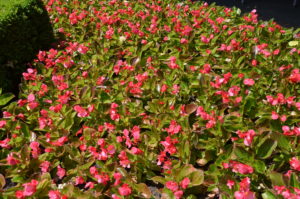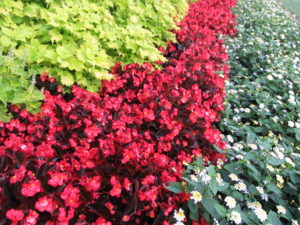Wax begonias (Begonia x semperflorens) are popular summer annuals in public and private gardens. Begonias are excellent for mass bedding, in mixed borders, and in large containers. Plants hold up to summer heat, humidity, and moderate dry spells. The foliage stays mostly pest and disease free.
A few years back, two series of interspecific hybrids (Begonia benariensis), were introduced by the Benary Seed Co. and trademarked as Big™ and Whopper™ begonias. These hybrids boast larger showier flowers than traditional wax begonias. Color choices in the Big series are red, rose and pink. Whopper series come in red and rose only. Whopper plants grow 20-25% larger than Big. This means fewer plants to plant for good garden coverage which will save you money.
Big™ begonias bloom non-stop for almost six months (mid-May thru October (USDA hardiness zones 6 thru 9). Big begonias are available in bronze-leaf (full sun) and green leaf (part sun) forms. Bronze-leaf types perform at their best (leaf color) in full sun, and green leaf cultivars prefer partial shade. Begonias need well-drained soils amended with lots of well-rotted compost.
In 2017 Pan American Seed released the Megawatt™ series. Current varieties include ‘Red Green Leaf’, ‘Pink Bronze Leaf’, ‘Rose Green Leaf’, ‘Red Bronze Leaf’ and ‘Rose Bronze Leaf’. Proven Winners (PW) has recently introduced Surefire™ Series with a red and a rose variety. Expect new color choices to be added over time.
All hybrid wax begonias grow robustly, 18 to 24 inches tall and 16-18 inches in spread, by the end of summer. Plants grow compact and are well-branched. Flower size varies from 2 to 3 inches across. The brightly colored blooms are visited by many kinds of butterflies over the long bloom season. Flowers are self-cleaning and require no deadheading. Space plants 15-18 inches apart depending on which series that you plant.
Begonias perform best with moderate fertility. At spring planting, feed with a slow-release fertilizer such as Osmocote™ 14-14-14 or Nutricote™ 13-13-13. One to two additional feedings in mid-summer with a water-soluble fertilizer (such as Miracle-Gro®, Schultz®, or Jacks®) are often needed in southern climates (zones 7-9). Add 2 to 3 inches of mulch to prevent weeds and to conserve soil moisture. Irrigate during extreme dry spells to maintain plant vigor and flowering.



 Posted in
Posted in 
